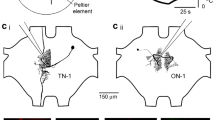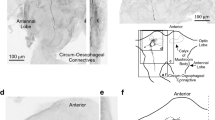Summary
In freely moving grasshoppers of the speciesChorthippus biguttulus compound potentials were recorded from the neck connectives with chronically implanted hook electrodes. The spikes of one large auditory interneuron, known as the G-neuron (Kalmring 1975a, b) were clearly distinguishable in the recordings and the neuron was identified by its physiology and morphology. In quiescent grasshoppers the G-neuron responds to auditory and vibratory stimuli, but responses to both stimuli are suppressed during stridulation in males (Fig. 1, top, Fig. 7). When a male's wings were removed so that the stridulatory movements of its hindlegs produced no sound, the suppression of the G-neuron response still occurred (Fig. 1, bottom). When proprioceptive feedback from the hindlegs was reduced, by forced autotomy of the legs, the switching-off remained incomplete (Fig. 3) (production of stridulatory patterns was inferred on the basis of electromyograms from the relevant thoracic musculature). Imposed movement of the hindlegs, on the other hand, suppressed the G-neuron response in a graded fashion, depending on the frequency of the movement (Figs. 4 and 5). These experiments suggest that the switching-off is brought about by a combination of proprioceptive feedback and central efferences. The switching-off phenomenon could either protect the grasshopper's auditory pathway from undesired effects of overloading by its own intense song (e.g. self-induced habituation as described by Krasne and Wine 1977) and should therefore apply for most auditory neurons. Alternatively it could prevent escape reflexes from being triggered by stridulatory self-stimulation and consequently might apply only for neurons involved in such networks (as the G-neuron might be).
Similar content being viewed by others
References
Bräuning P, Hustert R, Pflüger H-J (1981) Distribution and specific central projections of mechanoreceptors in the thorax and proximal leg joints of locusts. Part I. Cell Tissue Res 216:57–77
čokl A, Kalmring K, Wittig H (1977) The response of auditory ventral cord neurons ofLocusta migratoria to vibrational stimuli. J Comp Physiol 120:161–172
Elsner N (1975) Neuroethology of sound production in gomphocerine grasshoppers. Part II. J Comp Physiol 97:291–322
Fricke RA, Kennedy D (1983) Inhibition of mechanosensory neurons in the crayfish. Part III. Presynaptic inhibition of primary afferents by a central proprioceptive tract. J Comp Physiol 153:443–454
Hedwig B (1985) Untersuchungen zur Kontrolle des Feldheuschreckengesanges durch intersegmentale Interneurone. PhD thesis, Göttingen
Heitler WJ (1983) Suppression of a locust visual interneuron (DCMD) during defensive kicking. J Exp Biol 104:203–215
Helversen D von (1972) Gesang des Männchens und Lautschema des Weibchens bei der FeldheuschreckeChorthippus biguttulus (Orthoptera, Acrididae). J Comp Physiol 81:381–422
Helversen O von, Elsner N (1977) The stridulatory movements of acridid grasshoppers recorded with an optoelectronic device. J Comp Physiol 122:53–64
Kalmring K, Rheinlaender J (1974) The afferent auditory system of katydids and locustids. Mechanoreception. Abh Rhein-Westf Akad Wiss 53:313–323
Kalmring K (1975a) The afferent auditory pathway in the ventral cord of the migratory locust. I. J Comp Physiol 104:103–141
Kalmring K (1975b) The afferent auditory pathway in the ventral cord of the migratory locust. II. J Comp Physiol 104:143–159
Kämper G, Dambach M (1981) Response of the cercus-to-giant interneurone system in crickets to species-specific song. J Comp Physiol 141:311–317
Klinke R, Schmidt CL (1970) Efferent influence on the vestibular organ during active movements of the body. Pflügers Arch 318:352–353
Krasne FB, Wine JJ (1977) Control of crayfish escape behavior. In: Hoyle G (ed) Identified neurons and behavior of arthropods, Plenum Press, New York, pp 275–292
Lindberg D, Elsner N (1977) Sensory influence upon grasshopper stridulation. Naturwissenschaften 64:342
Marquart V (1985) Local interneurons mediating excitation and inhibition onto ascending neurons in the auditory pathway of grasshoppers. Naturwissenschaften 72:42–43
Mittelstaedt H (1970) Reafferenzprinzip: Apologie und Kritik. In: Keidel WD, Plattig U (eds) Vorträge der Erlanger Physiologentagung 1970, Berlin, S 161–171
Pearson KG, Heitler WJ, Steeves JD (1980) Triggering of locust jump by multimodal inhibitory interneurons. J Neurophysiol 43:257–278
Pichler F (1953) Beitrag zur Kenntnis der tympanalen Muskulatur der Feldheuschrecken. Zool Anz 150:12–15
Pringle JWS (1954) A physiological analysis of cicada song. J Exp Biol 31:525–560
Römer H (1976) Die Informationsverarbeitung tympanaler Rezeptorelemente vonLocusta migratoria. J Comp Physiol 109:101–122
Rowell CHF (1971) Antennal cleaning, arousal and visual interneurone responsiveness in a locust. J Exp Biol 55:749–761
Russel IJ (1976) Amphibian lateral line receptors. In: Llinás R, Precht W (eds) Frog neurobiology. Springer, Berlin Heidelberg New York, pp 513–550
Silver S, Kalmring K, Kühne R (1980) The responses of central acoustic and vibratory interneurons in bushcrickets and locusts to ultrasonic stimulation. Physiol Entomol 5:427–443
Sperry RW (1950) Neural basis of spontaneous optokinetic response produced by visual inversion. J Comp Physiol Psychol 43:482–489
Suga N, Jen PH-S (1975) Peripheral control of acoustic signals in the auditory system of echolocating bats. J Exp Biol 62:277–311
Wine JJ, Krasne FB (1982) The cellular organization of crayfish escape behavior. In: Bliss DE (ed) The biology of Crustacea 4. Academic Press, New York, pp 241–292
Wolf H (1984) Untersuchung akustischer Interneurone an freibeweglichen Heuschrecken der ArtChorthippus biguttulus. PhD thesis, Erlangen
Wolf H (1986a, b) Response patterns of two auditory interneurons in a freely moving grasshopper (Chorthippus biguttulus L.) I and II. J Comp Physiol A 158:689–696 697–704
Zaretzky M, Rowell CHF (1979) Saccadic suppression by corollary discharges in the locust. Nature 280:583–585
Zarnack W, Möhl B (1977) A data acquisition processor with data reduction for electrophysiological experiments. Fortschr Zool 24:321–326
Author information
Authors and Affiliations
Rights and permissions
About this article
Cite this article
Wolf, H., von Helversen, O. ‘Switching-off’ of an auditory interneuron during stridulation in the acridid grasshopperChorthippus biguttulus L.. J. Comp. Physiol. 158, 861–871 (1986). https://doi.org/10.1007/BF01324827
Accepted:
Issue Date:
DOI: https://doi.org/10.1007/BF01324827




